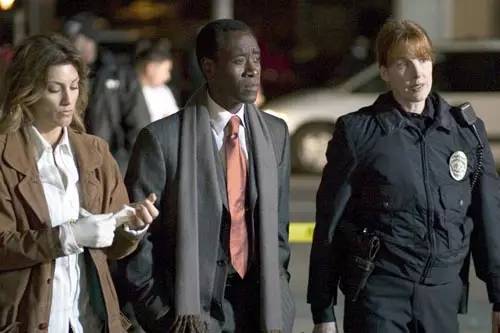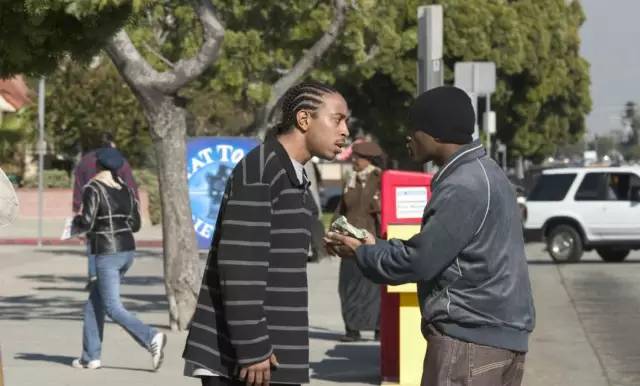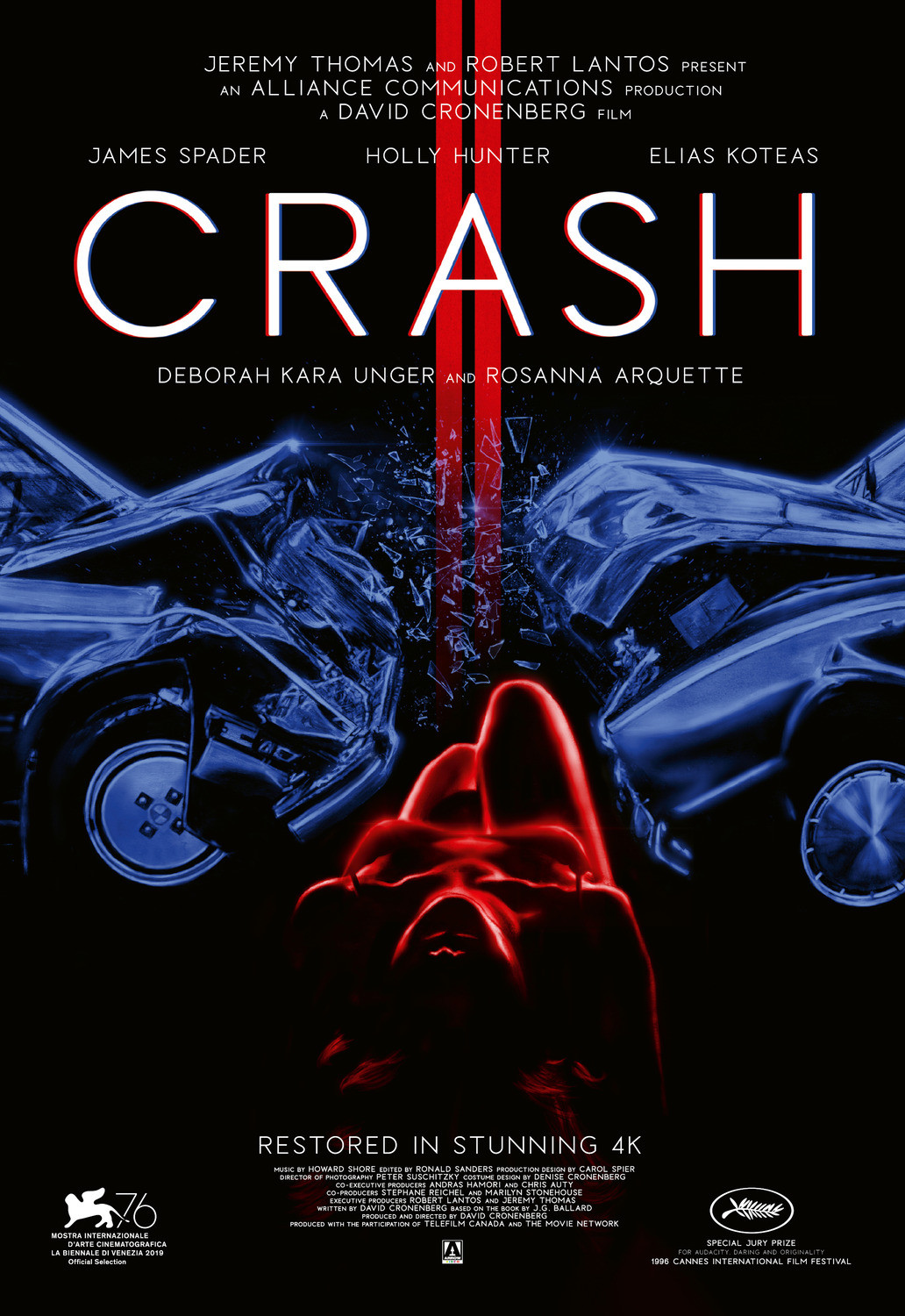Crash” is set in the eastern city of Los Angeles, a multicultural city with a large number of immigrants living together. The main characters include a white American prosecutor, a Persian businessman, a black car thief, a black police officer, a white police officer, a black TV director, a locksmith, and a Chinese immigrant, etc. There are several narrative clues such as a car thief robbing a white prosecutor’s car, a white prosecutor canvassing for votes, a white police officer molesting a TV director’s wife, a Persian businessman being robbed and shooting a locksmith, etc. The themes involve racial discrimination, love, affection, and crime. It can be said that there are many characters, intertwined clues, complex plot and profound themes. However, Haggis is able to narrate the film with ease and orderly, thanks to the skillful use of cross montage.
I. Cross-Montage
Cross montage is a development of parallel montage and alternating montage. Griffith in the “bleak villa” in the first use of parallel montage, that is, the simultaneous scenes cut into many pieces, alternately presented, so that the plot to the climax, and create suspense, later known as Griffith’s “last minute rescue”. Later in his “The Birth of a Nation” and “Party of One”, has been comfortable with the use of parallel montage and alternating montage techniques, and went on to create a rhythm montage and performance montage.
“Parallel montage is a form of montage structure in which two or several shots containing dramatic action or state of affairs are alternated and narrated separately to obtain parallel representation.” Parallel montage does not require the simultaneity of the narrative plot, and can even narrate events from different eras side by side, reflecting certain meanings from the juxtaposition or contrast of shots or shot combinations. For example, the Hong Kong film “Ruan Lingyu” articulates the film clips in which Ruan Lingyu acted, Maggie Cheung’s portrayal of Ruan Lingyu showing her private life, and the interview records of the cast and crew discussing the film, presenting different narrative levels, so that the same events and scenes in different time and space crash into each other and interpret each other in a bold way. Alternating montage is a montage structure form of alternating and parallel representation of two or more scenes occurring at the same time but interrelated, which is characterized by following a strict simultaneity. Crossover montage requires not only the simultaneity of multiple plot threads, but also the intersectionality and interdependence of plots, i.e. the interconnection and convergence of different threads. In the famous scene of “Odessa Steps” in “Battleship Bojangles”, the director crosses the scenes of officers and soldiers shooting, the crowd running away, and the mother and child (baby carriage), highlighting the inhumanity of the officers and soldiers and the innocence of the crowd. Crossover montage is often used to create a tense and intense atmosphere, to highlight the tit-for-tat of dramatic conflicts and to set up suspense.
In this film, the director crosses eight stories that take place in the same city in one day, making them advance in parallel, and the stories intersect with each other by the characters’ role transitions, forming a crossover network structure, which powerfully illustrates the clash of cultures and the complexity of human nature, and also makes the theme and form blend.

II. Story line
The film begins with a car crash in which a middle-aged Korean woman blames the car in front of her for braking too fast and causing a rear-end collision, while in the car in front of her is a black police officer and his assistant, where a murder happens to have occurred. When the black officer confidently and calmly went to handle the murder scene as usual, he found that the dead man was his long-sought brother. The screen flashes white and time travels back to the same city a day earlier.
Clue 1: Farhad, a Persian-American businessman, and his daughter Dorri go to a gun store to buy guns. 9/11 makes Americans insecure, and the owner mistakes them for Arabs, so an argument ensues, and Dorri casually asks for a red box of bullets and leaves in a hurry. Daniel suggests that both the door and the lock need to be replaced, but Farhad thinks Daniel is cheating him and gets angry. The next day, Farhad’s store is burglarized. The next day, Farhad’s store is burglarized. Since the insurance company cannot pay for it, Farhad’s decades of hard work is ruined. Pale Face believes that the theft is related to Daniel’s lock repair, so he retaliates with a gun. Faced with Daniel, he was furious and shot, at this time, the little daughter who thought she had an “invisibility cloak” flew at her father Daniel, and the gun went off, but the father and daughter were safe and sound. Close-ups tell us that the red box of bullets are empty.
Clue 2: Two young black people who survive by robbing and stealing cars, one is named Anthony, who complains about white people’s discrimination against black people; the other, who is somewhat religious, carries a statue of St. Christoph for shelter. But it was it that got them killed in the end. The two first robbed the white inspector Peter’s car, and on the way to escape, rolled a Korean under the car, and then escaped after taking him to the hospital door. Later, they robbed a black director Cameron’s car and were found by the police. Anthony was instead saved by the director and his companion escaped. Finally, Anthony stole the car of a Korean, when sold, found that the car is smuggled Chinese, he found conscience, refused the boss to buy smugglers high price, will be sent to the Chinese district. anth ony’s companion hitched a ride on a young police officer H ansen’s car, he found in the car is also a statue of St. Christopher, laughing more than, H ansen does not understand, stop the car to let it off, when the black When the young man took out the statue of St. Christoph from his pocket, H ansen was very alert and thought he was going to pull out a weapon, so he fired. Later, his brother, black detective G raham, came to investigate the case and found his brother dead.

Clue 3: black detective G raham and female detective R ia, the two are both partners and lovers. graham is African-American, a family of three, two brothers and mother. graham and female detective R ia to take over a shooting case, graham feel the case is complicated, want to investigate deeper, but the white inspector Peter is for the election and around to pull votes, want to quickly close the case. And Graham’s brother’s crime is also in the hands of the prosecution. Under pressure, Graham could only let the case be hastily closed. But his brother, due to a family spat the other day, ran away from home, so his mother asked Graham to retrieve him, only to have his brother killed.
Clue 4: Ryan, a police officer who has served in the police department for seventeen years, has a father who is seriously ill. His father was a janitor and had saved money for decades to start a company that employed all black people. Ryan was very unhappy about his father’s suffering and was also very worried about his father’s health. When Ryan calls the clinic, the “leader” of the clinic, a black woman named Shaniqua Johnson, claims there is nothing he can do. When he sees the black owner and his white wife in the car behaving ambiguously, he disregards the advice of his companion Hansen and takes out his anger on the two. In the presence of her husband Cameron, “searched” the body of his wife Christine. The next day, he encounters Christine again in a car accident where she is in an overturned car that is about to explode, and Ryan risks his life to rescue Christine.
Clue 5: Cameron, a black African-American director, has a successful career and is quite a gentleman. He is married to a white man named Christine, and they are questioned by police officer Ryan on their way home, and Christine is humiliated. After returning home, Chris-tine was furious and blamed her husband for not standing up for her. The next day, Christine went to the set to apologize to Cameron, but Cameron didn’t appreciate it. She was trapped in the car and the police came to her rescue, but when she found out it was Ryan, she sternly refused. Cameron is almost desperate to fight with the police to regain his dignity, but fortunately the young police officer Hansen was able to dissuade his partner from shooting him.
Clue 6: Peter, a senior local inspector, and his wife Jean, whose car was robbed, return home in a rage. Peter, who is often angry with his maids over trivial matters, is trying to get votes and has a shooting case hastily closed, and Jean, who was injured at home when she fell down the stairs, calls her husband, relatives and friends for help to no avail.
Clue 7: Hansen, a young police officer, has the ideals of a young man and is full of a sense of justice. He is not used to seeing R y an insulting black Cameron and Christine, and takes the initiative to find his boss to request a change of partners. On the way off duty, he gave a black youth a ride in his car. The black youth’s laughter in the car aroused his disgust, so he stopped the car to let him out. When the black youth was about to take out an icon from his pocket and the same as the car, Hansen shot him dead.
Clue 8: Daniel, a locksmith, is of Mexican descent and has a happy family of three with a well-behaved young daughter, L ara. For the safety of his family, he moved his home from a neighborhood where security was chaotic to another neighborhood where security was relatively good. At night, a gunshot sends Lara hiding under her bed, and Daniel pretends to give her a bulletproof invisibility cloak in order to persuade her to sleep peacefully, which Lara believes. Later, he goes to the Farhad store to fix the locks. He finds that both the locks and the door need to be replaced, and the owner thinks he is lying to him, so Daniel leaves. The next day, Farhad’s store is burglarized, and Farhad seeks revenge by shooting Daniel, but Lara uses her invisibility cloak to protect her father and save Farhad. This time it is Shaniqua Johnson’s car that is rear-ended, and the film ends in a brawl.
The Effect of Cross-Montage
Each clue is a complete story. Instead of telling each story one by one, the film relies on cross-montage to intertwine each story, so that the storyline slowly advances in fracture and stitching, parallelism and collision, thus making the meaning of the film expand in the spark of collision and the theme of the film sublimate in the stitching of fragments. The film’s excellent use of cross-montage combinations also allows the film’s conceptual conflicts to be reinforced by audiovisual images and gives narrative tension to the film’s plot advancement”. In terms of cultural spirit, the interwoven contrast structure ‘tells’ the story through the interwoven contrast of various narrative threads, which seems to be closer to the original nature of the evolution of human history itself. Because the reality is not always as full of coincidences as the classic Hollywood movie model: the bad guy is in charge, the good girl is in trouble, the hero saves the girl, and the couple is finally married, the ‘illusionary reality’ model. Rather, it is more of a mixture of positive and negative, civilization and barbarism, humanity and bestiality, and even dichotomy.”

First, the intersectionality in time and space. If we look at the main body of the film (i.e., starting with the flashback after the opening credits), several stories still advance in linear chronological order. The stories are concentrated in one day, while the film’s telling time averages only about ten minutes per story, in which the director divides each story into paragraphs alternating between them. For example, the story of clue five is divided into seven combined segments (i.e., the two are humiliated, arguing at home, reshooting on Cameron’s set due to black speech habits, Christine comes to the set to apologize to Cameron, Christine is involved in a car accident, Cameron’s car is robbed, and Cameron and Christine talk on the phone) to narrate the story. In between these six combination segments, staggered insertion of other clues of the combination of shots. This is the essential property of montage, that is, to construct the aberration of time and space in the film narrative through the division and integration of picture or sound, or even the unity of sound and picture. “The fundamental expression of the artistic creativity of montage lies in the fact that it creates a ‘new reality’ (Pudovkin’s words) rich in new meanings and passions through the recombination (construction of time) of the story material (the ability) of this paper, which is commonly referred to as the ‘ story world’.”
Second, the interlocking nature of the storylines. Vertically, each story advances in parallel, but horizontally, the stories intersect, and the intertwining of plots and bonding of characters weave the threads into an intertwined web. The carjacking in Clue 2 connects Clue 2 with Clue 5 and Clue 6, and the character G raham’s brother in Clue 2 connects it with Clue 3 and Clue 7. The “search” episode in clue four intertwines with clue five and directly drives the development of the clue five and clue seven storylines. Daniel’s lock fixing in Clue 8 is a direct result of the collision with Clue 1″. My goal in creating and shooting this film was to explore the topic of human relationships,” says director Haggis. The collision of characters, plot and clues, from point to line to surface, intertwine into a complex web of life connected by the relationship between people.
Finally, the contrasting tension of events. Between several narrative threads in this film, the events or characters with different styles and orientations constitute a contrasting relationship of obvious or implicit complexity, and through this contrasting tension, the narrative process of the story is advanced, and the narrative theme is then manifested. From a horizontal perspective, the contrast between the two partners, Anthony’s anger during the carjacking and Graham’s brother’s calmness, Officer Ryan’s brutality and brutality during the “body search” and young Officer Hansen’s calmness and integrity, Cameron’s patience and Christine’s outburst afterwards, and so on. The contrast between Cameron’s patience and Christine’s outburst after the incident. People may play many different roles in their lives, but there are two roles we all play: the person who hurts others and the person who is hurt by others. The film tells us that whether you hurt someone or someone else hurts you, love is the best way to heal. The film ends with the camera calmly sweeping across each person’s face, and we see that the faces of the main characters who have experienced hurt are written with remorse, heaviness, and even more love.
